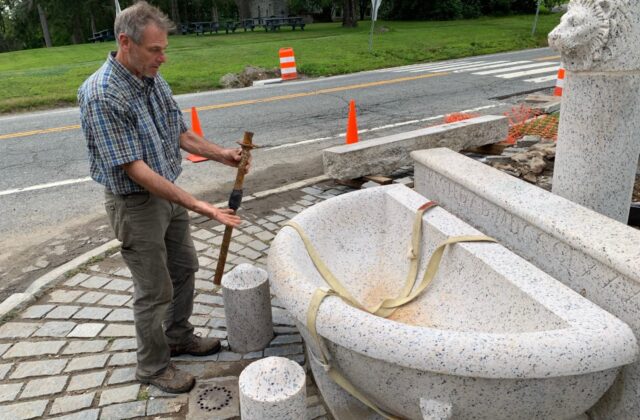Battell Fountain Is (Nearly) Back — Bring on the Band
Months-long restoration nearing completion
by Andra Moss
Since 1889, the Joseph Battell Memorial Fountain has greeted travelers as they approached the Norfolk village green from the south on Litchfield Road. The fountain’s unveiling on Sept. 27 of that year was heralded by the horns of a 24-piece military band (twice, in fact, once at 3 p.m. and again at 7 p.m.) and concluded with a sky full of fireworks—and rightly so. The Hartford Courant reported that week that the fountain, “was commissioned by Miss Mary Eldridge…designed by Mr. Stanford White, architect, of New York, and is an artistic gem in its way.”
The Norfolk Community Association agrees wholeheartedly and has commissioned Francis Miller of Conserve ART LLC to return the piece to its full glory—a four-month project that is very near completion. A tractor-trailer mishap some 12 years ago damaged the fountain and, while it was stabilized at the time, a full restoration was badly needed. “We knew that it was a priority,” says Doreen Kelly, co-president, with Barry Webber, of the Community Association. “It’s been three years since we started planning and raising the funds to restore it.”
Miller is a professional conservator and has brought a thoughtful and thorough approach to the project, from the initial site visit to in-depth historic research and meticulous selection and testing of materials.
“It’s an elegant monument, understated and simple,” says Miller. Stanford White, of Gilded Age trio McKim, Mead & White fame, designed the multiple components of the fountain. The horse trough, column, pedestrian drinking fountain, dog basins, bench and stepped plaza behind it are all made of white granite from Milford, Mass., adorned with the naturalistic bronze ornamentation created by White’s good friend and frequent collaborator, sculptor Augustus Saint-Gaudens. Miller points to the globe atop of column. “Saint-Gauden’s fish are just beautifully designed; a combination of both being cloaked and in the water, seeming to reflect mourning and life,” perhaps referencing the memorial aspect of the commission.
As impressive as it is, nearly every piece of the monument needed repair, and this work started in earnest in June, when Miller took down the bronze fish globes, two lantern arms and lantern posts. The bronze had been reassembled in some intervening period with iron hardware, which had caused staining and cracking. Miller is replacing the old hardware with copper alloy brass that will not rust or expand. He has thoroughly cleaned the original bronze material (“some critter had quite a nest underneath the dome of one of the lights”) and applied a protective wax coating to halt corrosion.
By July, Miller was ready to move on to the stone. But, as he noted in no small understatement, “Fountains are complicated.” Well over 100 years of staining and rust were addressed with a buffered acidic solution to remove atmospheric and metallic staining, especially in the horse trough, which had an iron drain, now replaced with brass. He also had to reset the horse trough, as it had come out of alignment, and repoint the bench and large granite steps. Next, he flushed the drains and improved the plumbing underneath.
Historic photos revealed that the pebbled landing behind the column once surrounded the entire monument. Miller is washing those pebbles that can be salvaged and will find new matching stones to replace those that cannot. He will then reset the full walkway behind the column. The sundial and its polished marble stand, a later addition to the composition, are now fully incorporated into the site.
The replacement carving of the lion’s jaw, which had gone missing some years back, is now in the able hands of master stone carver Christoph Henning. Historic photos provided by Webber from the Norfolk Historical Society clearly show the full lion’s head midway along the column. “It’s quite a lovely, whimsical carving with the tongue sticking out,” says Miller. Henning brought sample chips to the site to match the color of the Milford granite as closely as possible. Incidentally, it is impossible not to share that the German-born Henning now lives in Berlin, Conn., where he heads Schall and Staub
(‘Noise and Dust’) Enterprises.
The restoration has unfolded in stages. Leaks were discovered and patched, and cracks repaired. Historic materials were sourced for the entire project. When cutting out the mortar joints behind the monument, Miller uncovered a woman’s diamond ring. There was momentary hope that the entire project (still short of its budgetary goal) could be funded from this glittering historic find, until closer examination revealed the phrase “Made in China” on the band.
Soon, though, the project will be complete. Once again, as the Hartford Courant reported in 1889, will “Two bronze lanterns, studied from the famous lantern on the angle of the Strozzi palace in Florence, hang from brackets projecting from the pillar just below the capital. These have a beautiful effect at night lighting up the white granite of the fountain and reflecting in the basin and on the numerous jets of water pouring into it.”
Miller is moved by the responses he has been receiving about the restoration. “This may be the most loved monument by a community,” that he’s ever worked on, he says. “So many people have come up to me, thanked me, for this work. It is touching for me, having that kind of kind of recognition and support.”
“The people here know this work. They use it—one man told me he has drunk from it for 30 years—and it has a place in everyone’s hearts.”

